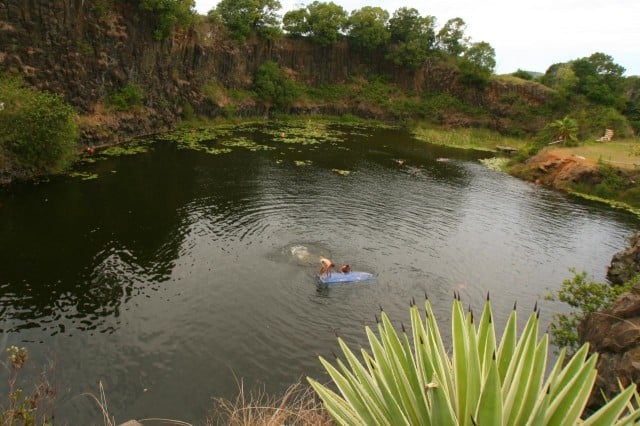Coronial inquest hears of multiple injuries at quarry death site

The Island Quarry at Byron Bay where Brendan Vickery died in February 2014 after jumping from a cliff into the water. Photo rodc/flickr.com
Jim Beatson
Dark details and important lessons emerged on day one of the coronial inquest at Byron Bay Court into the death of 20-year-old Brendan Vickery.
He died on February 23, 2014, at the astonishingly beautiful, but dangerous Island Quarry, opposite the Cavanbah Centre on Ewingsdale Road.
The main feature at the quarry is a large waterhole. Brendan’s body was found under that water by police.
On Monday (December 11) the first witness was Luke Johnston.
He said that he was friends with Brendan, Rex, Drew and Elliott, some of whom had driven up from Sydney the day before.
‘We went to bed around 9.30 or 10pm on the Saturday,’ Mr Johnston said.
After a cruisy Sunday morning, starting at 8.30am, the friends arrived at the quarry in the early afternoon.
At its centre is a waterhole, a quarter of which is covered in lotus blossoms and lily pads. One side has a high cliff and the other a grassy flatland just above water-level.
Mr Johnston said there were no signs against trespassing at the entrance of the quarry. Just a sign saying, ‘You Are Here At Your Own Risk.’
Mr Johnston told the hearing ‘I’d heard that people had broken their back there previously, but it didn’t worry me. Drew may have told me. The only thing that might have worried me was the height [of the cliff].’
Mr Johnston also explained there were no notices providing people with a list of the many serious injuries that had taken place there.
In 2012, Swedish backpacker Emma Weisglas, then aged 20, smashed her vertebrae when she hit the water at speed.
In the previous year, 15-year-old Jack Pollock and a 21-year-old American backpacker were so severely injured they were almost paralysed while ‘tombstoning’ at the same location.
Dr Robert Davies, network director for emergency departments at four hospital sites across the Northern Rivers told the inquest there had been ‘many cases over several years with spinal fractures and near drownings.’
He explained there had been ‘ten notified hospital injuries with six being fractures of the spine. A majority having multiple fractures.’
Confronted with this information, Mr Johnston explained ‘It’s an adrenaline thing to do it [jump]. It was a surprise to hear a history of injuries…Had I known this it may have deterred me.’
Mr Johnston was an experienced cliff jumper since jumping in a rock quarry waterhole in Melbourne. ‘Where’s there’s no oxygen in the water, no buoyancy (sic). You have to tread water to keep afloat’.
At the top of the overhanging cliff, a dozen meters or more above the level of the water,Mr Johnston saw a sign saying ‘something about unstable rock’. WhileMr Johnston did jump from there, he told the inquest he dropped a stone into the water first, to break the water’s surface tension.
Mr Johnston said Brendan didn’t jump but looked at another much lower ledge only 3 to 5 metres above the water level.Mr Johnston explained, ‘we were both good swimmers, but [Brendan] was uncertain about jumping’ ‘He was not a fitness junkie’ ‘There was no pressure on him to jump other than “you can do it mate”.’
How it happened
From yesterday’s evidence, the friends were often at separate locations at the waterhole.Mr Johnston said ‘I didn’t hear him jump [from the high cliff]. I think [he must have] banged his head because his foot slipped [from jumping from the lower ledge].’ Asked if he would have called out if he had been in trouble, Mr Johnston agreed ‘[Brendan] would have sung out if he felt he was in trouble’.
Later one of the group noted Brendan called out he was ‘pretty puffed’ (sic)’. But no one noticed Brendan’s disappearance for what then appears to be around 20 minutes. When group noticed his absence, Luke went to top of the cliff to look down from above and checked to see if he was in the car. After ‘30 to 40 minutes we rang the police.’
Later the police found Brendan’s body. At yesterday’s hearing no explanation was provided as to why an autopsy was not conducted. Dr Davies noted there was ‘always danger with still water.’
‘There may have been a pre-existing condition, also he could have had an adrenaline rush from the situation. In medicine anything is possible.’
Dr Davies added ‘We suspect many injuries are not reported especially by overseas visitors’.
He described a case of an overseas visitor who didn’t report a burst lung which happened at the site until the following day.
More importantly he said it was ‘quite frustrating that we were trying to get a message out about the pattern of injuries there, but there was no good system in place.’
The quarry is sited on Crown Land, leased to Byron Shire Council, who in turn lease it to the Island Quarry Reserve Trust. ‘Neither Crown Lands nor Byron Shire Council saw it as their problem. Their actions did not match the severity of the situation.’ The doctor also noted social media actively promoted the little-known dangerous waterhole.
Dr Davies said in November 2011, his predecessor ‘Dr Winston McKean, had approached [the president of] the Island Quarry Reserve Trust, Shane Rennie, regarding the ongoing pattern serious accidents and proposed filling in the waterhole.’
The inquest was adjourned at just after 4 PM.
On Tuesday morning, Mr Rennie and others are expected to take the stand. The inquest may conclude by Wednesday afternoon. The lessons may take longer to learn.
No comments:
Post a Comment